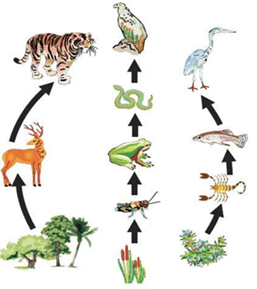NCERT Solutions Class 7 Science Chapter 1 Nutrition in Plants is provided here to help students in understanding the topic thoroughly. All these solutions are solved by experts with a detailed explanation. Class 7 NCERT Solutions for Science Chapter 1 includes all the textbook exercise questions and answers. These solutions will help students complete their assignments & homework.
Class 7 Science Nutrition In Plants Questions and Answers
Exercise Questions
Question 1: Why do organisms need to take food?
Answer: All organisms need to take food to get energy for the growth, development and maintenance of their bodies.
Question 2: Distinguish between a parasite and a saprotroph.
Answer: Difference between a parasite and a saprotroph:
| Parasite | Saprotroph |
| Organisms derive nutrition from the body of other living organisms (host) are parasites. | Plants which derive nutrition from dead and decaying organisms are called saprotrophs. |
| Example: Cuscata (Amarbel) | Example: Mushrooms. |
Question 3: How would you test the presence of starch in leaves?
Answer: Iodine solution is used to test leaves for the presence of starch.
In order to perform this test, one needs to heat the plant leaf in boiling water for 30 seconds to 1 minute and after that heat in boiling ethanol for a few minutes. Wash with water and spread onto a white tile and add a few drops of iodine solution. The parts of the leaf that contains starch will change its colour blue-black.
Question 4: Give a brief description of the process of synthesis of food in green plants.
Answer: Green plants use a process called as photosynthesis to prepare their food. The process is as follows
(a) Water is taken in from the roots of the plant and is transported to the leaves.
(b) Carbon dioxide from the air enters the leaves through the tiny pores called stomata and diffuses to the cells containing chlorophyll.
(c) Solar energy is used to break water into hydrogen and oxygen.
(d) This hydrogen is combined with carbon dioxide to form food for the plants, which is ultimately used by the animals as well.
Photosynthesis is represented by the following equation.

Question 5: Show with the help of a sketch that the plants are the ultimate source of food.
Answer: All the living being depends on plants whether directly or indirectly. For example, the plant-eater animals depend directly on plants but carnivore depends indirectly on plants. The following sketch shows some examples of plant dependency.

Question 6. Fill in the blanks:
(a) Green plants are called _________________ since they synthesise their own food.
Answer (a): Autotrophs
(b) The food synthesised by plants is stored as _________________.
Answer (b): Starch
(c) In photosynthesis solar energy is absorbed by the pigment called ___________.
Answer (c): Chlorophyll
(d) During photosynthesis plants take in ______________________ and release __________________ gas.
Answer (d): Carbon dioxide, Oxygen
Question 7. Name the following:
(i) A parasitic plant with yellow, slender and branched stem.
Answer (i): Cuscuta
(ii) A plant that is partially autotrophic.
Answer (ii): Pitcher plant
(iii) The pores through which leaves exchange gases.
Answer (iii): Stomata
Question 8. Tick the correct answer:
(a) Cuscuta is an example of:
(i) autotroph
(ii) parasite
(iii) saprotroph
(iv) host
Answer: (ii) Parasite
(b) The plant which traps and feeds on insects is:
(i) Cuscuta
(ii) china rose
(iii) pitcher plant
(iv) rose
Answer: (iii) Pitcher plant
Question 9: Match the items given in Column I with those in Column II:
| Column- I | Column-II |
| Chlorophyll | Rhizobium |
| Nitrogen | Heterotrophs |
| Cuscuta | Pitcher plant |
| Animals | Leaf |
| Insects | Parasite |
Solution:
| Column- I | Column-II |
| Chlorophyll | Leaf |
| Nitrogen | Rhizobium |
| Cuscuta | Parasite |
| Animals | Heterotrophs |
| Insects | Pitcher plant |
Question 10. Mark ‘T’ if the statement is true and ‘F’ if it is false:
(i) Carbon dioxide is released during photosynthesis. (T/F)
(ii) Plants which synthesise their food are called saprotrophs. (T/F)
(iii) The product of photosynthesis is not a protein. (T/F)
(iv) Solar energy is converted into chemical energy during photosynthesis. (T/F)
Answer:
(i) False
(ii) False
(iii) True
(iv) True
Question11. Choose the correct option from the following:
Which part of the plant takes in carbon dioxide from the air for photosynthesis?
(i) Root hair
(ii) Stomata
(iii) Leaf veins
(iv) Petals
Answer: (ii) Stomata
Question 12. Choose the correct option from the following:
Plants take carbon dioxide from the atmosphere mainly through their:
(i) roots
(ii) stem
(iii) flowers
(iv) leaves
Answer: (iv) Leaves
Question13. Why do farmers grow many fruits and vegetable crops inside large green houses? What are the advantages to the farmers?
Answer: Fruits and vegetable crops are grown in large greenhouses because it protects crops from the external climatic condition and to provide suitable temperature for the growth of crops.
Advantages to farmers while growing fruits and vegetable crops inside greenhouses are
- It protects crops from diseases and adverse climatic conditions.
- It protects crops from wind and rodents
Having a good grasp over CBSE NCERT Solutions for Class 7 Science will further help the students in their preparation for board exams and other competitive exams. NCERT Solutions for Class 7 Science Chapter 1 Nutrition in Plants provided by CBSE Path help students to clear their doubts and to obtain good marks in the exams. All the solutions provided in this article are strictly based on the CBSE syllabus and curriculum.